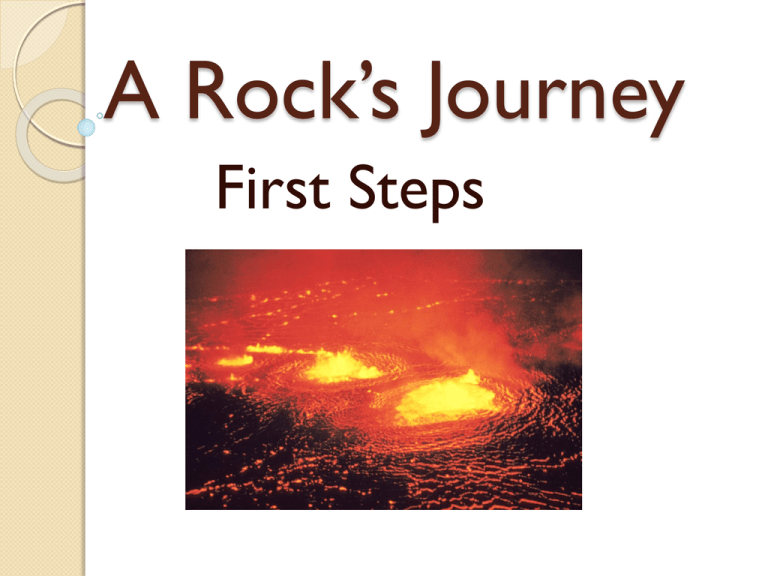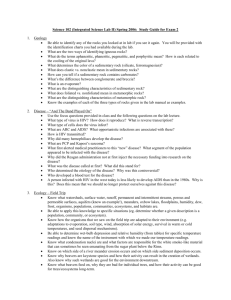A Rock*s Journey
advertisement

A Rock’s Journey First Steps Igneous Rocks Before rocks, there was ◦ Magma Molten crystals that flow like a liquid. After these molten mineral grains cool, they form a specific type of rock called ◦ Igneous rocks These rocks come in three different and unique forms ◦ Intrusive ◦ Extrusive ◦ Volcanic Glass Igneous Rocks Intrusive rocks ◦ Form in the depths of the Earth over thousands of years This time allows them to form very ◦ Large mineral grains Igneous Rocks When magma reaches the surface and cools there, it forms ◦ Extrusive rocks With very ◦ Small ◦ mineral grains Igneous Rocks The violence of volcanoes causes mineral grains to be thrown into the air where they cool so quickly they have ◦ Little or no ◦ Mineral grains These rocks are called ◦ Volcanic glass rocks Igneous Rocks Although similar in general shape and structure, these three types have different “races” within them: ◦ Basaltic ◦ Granitic ◦ Andesitic Igneous Rocks Basaltic rocks are ◦ Dense, dark-colored rocks ◦ Formed from magma that contains lots of the elements Iron and magnesium In opposition, granitic rocks are ◦ ◦ ◦ ◦ Light colored rocks With a Lower density Than basaltic rocks because it contains a lot of the compound silica (SiO2) Finally, there are those rocks which find themselves with a bit of basaltic and a bit of granitic properties; these rocks are called ◦ Andesitic Igneous Rocks Igneous Rocks Metamorphic Rocks Once rocks form solid and strong, they must face the perils of this earth. Those rocks that face the most extreme conditions of earth form brilliant rocks that are even stronger than before. These rocks are called ◦ Metamorphic rocks Metamorphic Rocks The rock that forms into the metamorphic rock is called the ◦ Parent rock Metamorphic Rocks The same ingredient mineral grains take on many forms depending on the amount of ◦ Heat and/or pressure ◦ they experience Metamorphic Rocks Forces experienced by rocks can come from either the ◦ Weight of the Earth pressing down on the rocks ◦ The extreme temperature created near the Earth’s core ◦ Or the contact of the rocks with hot lava, also called magma Metamorphic Rocks These powers force the mineral grains to flatten and move positions If the mineral grains form into layers, the new metamorphic rock is called a ◦ Foliated rock If, however, they move into random positions, they are called ◦ Non-foliated rocks Metamorphic Rocks Foliated Non foliated Offspring becoming Parents How metamorphic rocks are formed Increasing Pressure & Temp Categorizing Metamorphic Rocks Sedimentary Rocks Rocks formed when fragments of other rocks come together to form a new rock Sedimentary Rocks Three types of Sedimentary Rocks ◦ Detrital ◦ Chemical ◦ Organic Sedimentary Rocks Detrital Rocks ◦ Steps of Creation 1. Rock broken Weathering and Erosion 2. Compaction Squeezed together 3. Cementation Water drips between and solidifies Sedimentary Rocks Classified by size and shape Sedimentary Rock Chemical Sedimentary ◦ Rocks from solution Limestone & Rock Salt Sedimentary Rocks Organic sedimentary rocks ◦ Made from once living material Sedimentary Rocks As humans do, some rocks will break up with their partners and form new bonds with new partners. These new blended families are called sedimentary rocks. They form from the broken, shattered pieces or rocks and shells, called sediment, that have been torn from their parent rocks by harsh wind and raging water. These blended families come in three very different categories: detrital, chemical, and organic. Sedimentary Rocks The most common form is when pieces of sediment are forced together under pressure to form detrital rocks. This process occurs in three stages. First, the rock is broken down by weathering and erosion, which is the movement of weathered materials. Second, the sediments get closer and closer through a process called compaction. Finally, new water joins the mix and solidifies the bonds through cementation.These rocks are classified by the size and shape of their sediments. Sedimentary Rocks Like people of the same race, rocks of the same type are still vastly different from each other. Out of solution come chemical sedimentary rocks. These rocks form when pieces of sediment that were dissolved in water come together and form a solid rock. Two examples of these rocks are limestone and rock salt. The rocks that aren’t really rocks are called organic sedimentary rocks because they are made of once-living material. Two examples of these rocks are coal and chalk. Rock Cycle How rocks recycle Rock Cycle







